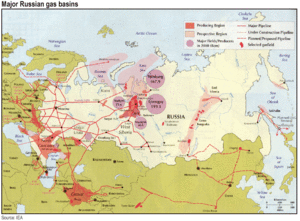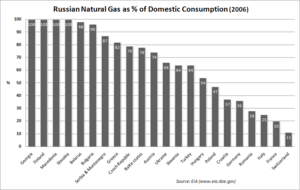Gazprom facts for kids
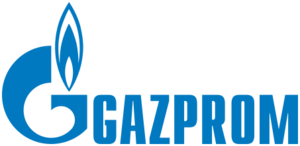 |
|
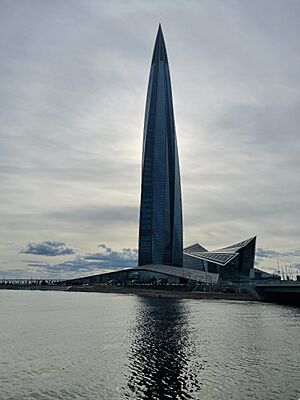
Gazprom's headquarters in the Lakhta Center in Saint Petersburg, the tallest building in Europe
|
|
|
Native name
|
ПАО "Газпром"
|
|---|---|
| State-owned company Public (PAO) |
|
| Traded as |
|
| Industry | Oil and gas |
| Founded | 8 August 1989 |
| Headquarters | Lakhta Centre, , |
|
Key people
|
|
| Products | Petroleum Natural gas Petrochemicals |
| Services | Gas pipeline transport |
| Revenue | $87.7 billion (2020) |
|
Operating income
|
$8.53 billion (2020) |
| $2.25 billion (2020) | |
| Total assets | $324 billion (2020) |
| Total equity | $205 billion (2020) |
| Owner | Russian government (50.23%) |
|
Number of employees
|
466,000 (2018) |
| Subsidiaries | List of subsidiaries |
PJSC Gazprom is a very large Russian energy company. It is mostly owned by the Russian government. Its main office is in the Lakhta Center in Saint Petersburg, Russia. The name Gazprom comes from Russian words meaning "gas industry."
Gazprom is involved in every part of the gas business. This includes finding gas, drilling for it, cleaning it, moving it through pipelines, selling it, and even making electricity. In 2018, Gazprom produced about 12% of the world's natural gas. By 2023, this share had changed. The company also exports gas through its own pipelines, like Power of Siberia and TurkStream.
Gazprom also produces a lot of oil through its company Gazprom Neft. It has other companies too, in areas like finance, media, and aviation.
Gazprom started in 1989. It was formed when the Soviet Ministry of Gas Industry became a company. It was the first state-run company in the Soviet Union. After the Soviet Union broke apart, Gazprom became a private company. Later, in the early 2000s, the Russian government took back control. Since then, Gazprom has been important in Russia's international relations, especially concerning gas prices and pipelines.
Contents
History of Gazprom
How Gazprom Started
During World War II in 1943, the Soviet Union began to develop its own gas industry. By 1965, the government controlled all gas activities. This included finding, developing, and distributing gas. In the 1970s and 1980s, large natural gas fields were found in Siberia and other Russian regions. This made the Soviet Union a major gas producer.
In August 1989, the Ministry of Gas Industry changed its name to State Gas Concern Gazprom. It became the first state-run company in the Soviet Union. When the Soviet Union broke up in late 1991, gas assets were given to new national companies. Gazprom kept the assets located in Russia. It became the main company for gas in Russia.
Becoming a Private Company
In December 1992, Viktor Chernomyrdin, who was Gazprom's Chairman, became the Prime Minister of Russia. This made Gazprom more powerful. The company then became a joint-stock company. This meant people could buy shares in it.
Gazprom started selling shares using a "voucher method." Russian citizens received vouchers to buy shares in former state-owned companies. By 1994, many people and Gazprom employees had bought shares. The government kept a large part of the shares. Foreigners were not allowed to own too many shares at first.
During this time, Gazprom did not always follow all state rules. Some of its assets were moved to other companies.
Government Takes Control Again
In June 2000, Vladimir Putin became the President of Russia. He wanted the government to have more control over important companies. Putin removed Chernomyrdin from the Gazprom board. He also replaced other leaders with people he trusted. Their job was to fix problems and get back lost assets.
In April 2001, Gazprom bought NTV Russia, which was Russia's only independent TV station. This showed Gazprom's growing influence in media.
In June 2005, the Russian government gained majority control of Gazprom. This happened when state-owned companies bought more shares. The government then allowed more foreign investment in Gazprom. In September 2005, Gazprom bought the oil company Sibneft for a large sum of money. Sibneft was renamed Gazprom Neft. This made Gazprom Russia's largest company.
In July 2006, a new law gave Gazprom the only right to export natural gas from Russia. In December 2006, Gazprom made a deal to take control of Sakhalin Energy, a big energy project.
In June 2007, another company, TNK-BP, sold its share in the Kovykta field to Gazprom. This happened after the Russian government questioned BP's right to export gas.
Gazprom also worked on new pipelines. In 2007, Russia and Italy agreed to build the South Stream pipeline. This pipeline would carry gas from Russia to Europe under the Black Sea. However, in December 2014, the South Stream project was stopped. Instead, gas was planned to be shipped to Turkey through a new pipeline called TurkStream.
Continued Growth and Changes
In September 2012, the European Commission started an investigation into Gazprom. They were concerned that Gazprom might be unfairly using its strong position in the gas market.
In May 2014, Gazprom and the China National Petroleum Corporation (CNPC) signed a huge contract. This deal was worth $400 billion over thirty years. Gazprom agreed to send 38 billion cubic meters of natural gas to China each year. Construction began on the Power of Siberia pipeline to make this possible. Gas supplies to China started in December 2019.
In September 2015, agreements for the Nord Stream 2 pipeline were signed. This pipeline was completed by July 2021.
Changes in European Sales
After events in February 2022, Russia reduced gas supplies to Europe. This greatly affected Gazprom's export market. Gazprom's exports fell from 185 billion cubic meters in 2021 to 100 billion in 2022. They fell again in 2023. By 2023, Europe was buying only 28 billion cubic meters, a level not seen since the 1970s. This led to a trading loss for Gazprom. As a result, gas prices in Russia's domestic market were planned to increase by 34% over three years.
Gas Supply and Reserves
Gas Production
In 2011, Gazprom produced about 513 billion cubic meters of natural gas. This was 17% of the world's total production and 83% of Russia's production. Most of this gas came from fields in Western Siberia. The largest fields, like Medvezhe, Urengoy, and Yamburg, have been producing for over twenty years. Their production has slowly decreased. Gazprom has kept its production levels by starting new, smaller fields and buying assets from other companies.
Gazprom Neft is the company that produces crude oil for Gazprom. In 2005, Gazprom bought 75% of Gazprom Neft's shares.
| billion cubic metres | 2004 | 2005 | 2006 | 2007 | 2008 | 2009 | 2010 | 2011 | 2012 | 2013 | 2014 | 2015 | 2016 | 2017 | 2018 | 2019 | 2020 | 2021 |
|---|---|---|---|---|---|---|---|---|---|---|---|---|---|---|---|---|---|---|
| Natural gas | 552.5 | 555.0 | 556.0 | 548.6 | 549.7 | 461.5 | 508.6 | 513.2 | 487.0 | 487.4 | 443.9 | 418.5 | 419.1 | 472.1 | 498.7 | 501.2 | 454.5 | 515.6 |
| million tons | 2004 | 2005 | 2006 | 2007 | 2008 | 2009 | 2010 | 2011 | 2012 | 2013 | 2014 | 2015 | 2016 | 2017 | 2018 | 2019 | 2020 | 2021 |
| Crude oil | 0.9 | 9.5 | 34.0 | 34.0 | 32.0 | 31.6 | 32.0 | 32.3 | 33.3 | 33.8 | 35.3 | 36.0 | 39.3 | 48.6 | 48.3 | 48.0 | 47.1 | 48.2 |
| Condensate | 11.1 | 11.5 | 11.4 | 11.3 | 10.9 | 10.1 | 11.3 | 12.1 | 12.9 | 14.7 | 14.5 | 15.3 | 15.9 | 15.9 | 15.9 | 16.7 | 16.2 | 16.3 |
| Source: Gazprom in figures 2004–2008, 2007–2011, 2009–2013 and 2012–2016. 2017-2019 2020-2021 | ||||||||||||||||||
Gas Reserves
In 2015, Gazprom had about 23.7 trillion cubic meters of natural gas reserves. This was about 18.4% of the world's total reserves. The company also had large reserves of crude oil and gas condensate. Most of Gazprom's gas reserves are in the Urals Federal District and the Arctic shelf.
| trillion cubic metres | 2004 | 2005 | 2006 | 2007 | 2008 | 2009 | 2010 | 2011 | 2013 | 2015 | 2019 | 2021 |
|---|---|---|---|---|---|---|---|---|---|---|---|---|
| Natural gas | 20.90 | 20.66 | 20.73 | 20.84 | 21.28 | 21.95 | 22.52 | 22.84 | 23.26 | 23.71 | 34.89 | 30.22 |
| Source: Gazprom in figures 2004–2008, 2007–2011 and 2009–2013. 2019 2021 | ||||||||||||
Developing New Gas Fields
Gazprom invests a lot of money in new projects to keep its gas supply steady. Many of its future reserves are in the Yamal Peninsula and the Barents Sea.
Blue Stream Pipeline
One important project is the Blue Stream Pipeline. This pipeline carries natural gas to Turkey by going under the Black Sea. It started operating in 2000.
Yamal Peninsula Project
The Yamal Peninsula has huge reserves of natural gas, over 10 trillion cubic meters. About 60% of these reserves are in three main fields: Bovanenkovo, Kharasavey, and Novoportovo. The Bovanenkovo field alone can produce a lot of gas each year.
Shtokman Field
The Shtokman field is one of the world's largest natural gas fields. It is located in the Barents Sea. This field is estimated to hold up to 3.7 trillion cubic meters of gas. Gazprom is working with other companies to develop this field.
Exploration Around the World
Gazprom also looks for gas and oil in other countries. These include India, Pakistan, Algeria, Venezuela, and several countries in Central Asia.
Transporting Gas
Gazprom has the largest gas transportation system in the world. It includes over 158,000 kilometers of gas pipelines and many compressor stations. This system moves huge amounts of gas.
Liquefied Natural Gas (LNG)
Russia has two large plants that produce liquefied natural gas (LNG). Gazprom has an interest in both of them: Yamal LNG and Sakhalin-2 LNG. LNG is natural gas that has been cooled to a liquid form. This makes it easier to transport by ship.
In March 2021, the Russian government approved a plan to build nine more LNG plants. This is to meet the growing demand for LNG around the world. In 2024, Gazprom faced a shortage of LNG tankers. This meant they had to use a special floating storage unit to export LNG from one of their facilities.
Selling Gas
Gazprom sells gas to customers in Russia and to many countries in Europe and other former Soviet countries. In 2006, about 60% of Gazprom's money came from sales to European customers.
Gas prices can change a lot. In 2007, the price of natural gas in New York was about $285 for 1,000 cubic meters. At the same time, German customers paid about $250, and Russian customers paid much less.
Since 2022, because of falling export money, gas prices for customers in Russia have been increasing.
Gas Exports
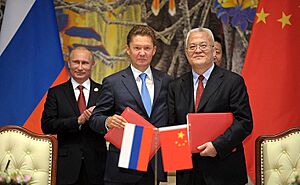
Gazprom sends gas to 25 European countries. Its main export company is Gazprom Export LLC. This company has the only right to export gas to countries outside the former Soviet Union. Most Russian gas in Europe was sold through long-term contracts.
In 2014, Europe provided 40% of Gazprom's income.
In May 2014, Russia and China signed a $400 billion deal. Under this contract, Russia agreed to supply 38 billion cubic meters of gas to China every year for 30 years.
In January 2023, Gazprom announced that its gas exports fell by 45%. This was mainly because of the loss of the European market. By 2023, Europe was buying much less gas from Gazprom than before.
Gas Price Discussions
Sometimes, Gazprom has had disagreements over gas prices. For example, on January 1, 2006, Gazprom stopped supplying gas to Ukraine for a short time. This was because Gazprom wanted Ukraine to pay more for gas, closer to global prices. A deal was reached a few days later.
In December 2006, Gazprom also threatened to stop gas supplies to Belarus. This was because Belarus did not agree to pay a higher price for gas. A last-minute agreement was signed on January 1, 2007. Under this deal, Belarus agreed to pay $100 per 1,000 cubic meters. Gazprom also bought shares in Belarus's pipeline network.
On April 1, 2014, Gazprom increased the gas price for Ukraine. Later that year, in October, Russia agreed to restart gas supplies to Ukraine for the winter.
How Gazprom Works
Gazprom is a "vertically integrated" company. This means it owns all the different parts of its business. It owns its gas processing plants and the main gas pipelines in Russia. Since 2006, it has been the only company allowed to export gas from Russia. Other gas producers in Russia must use Gazprom's facilities to process and transport their gas.
At the end of 2008, Gazprom had over 221,000 employees. Gazprom's main office was in Moscow until 2021. It then moved to the Lakhta Centre in Saint Petersburg.
Gazprom is considered a "national champion" in Russia. This means it is expected to not only make money but also help Russia's national interests. For example, Gazprom sells gas to people in Russia at a lower price than it sells to other countries. In 2008, Gazprom's activities made up 10% of Russia's total economy.
Who Owns Gazprom
As of 2017, the Russian government was the main owner of Gazprom. It held over 50% of the shares through different government agencies. The rest of the shares were owned by investors, including those on foreign stock markets.
Gazprom's shares are traded on the Moscow Exchange. It used to be listed on other stock exchanges around the world before 2022.
Gazprom's Other Companies
Gazprom has hundreds of other companies, called subsidiaries. These are located in Russia and other countries. They are owned and controlled by Gazprom. Some of these include Gazprom International UK Ltd in the United Kingdom and Gazprom International Projects BV in the Netherlands.
Sports Sponsorships
Gazprom is a big sponsor in sports. It owns and sponsors the Russian football club FC Zenit Saint Petersburg. It also sponsors other sports teams like basketball and volleyball clubs. Gazprom also owns SKA St Petersburg, a hockey club.
On January 1, 2007, Gazprom became a sponsor of the German football club FC Schalke 04. This partnership lasted for many years. However, after events in February 2022, Schalke suspended their sponsorship with Gazprom.
Gazprom also sponsored the Serbian football club Red Star Belgrade. It was also a "Gold Partner" for the Russian professional cycling team, Team Katusha.
In July 2012, Gazprom became a partner of the UEFA Champions League and UEFA Super Cup. This sponsorship continued for several seasons. Gazprom was also a global partner for the UEFA Euro 2020 and UEFA Euro 2024 football tournaments. However, due to events in February 2022, Gazprom's sponsorship for these tournaments ended.
Environmental Impact
Gazprom is one of the world's largest emitters of greenhouse gases. This includes the gases released when its products are used. A large part of Russia's greenhouse gas emissions come from methane leaks and Gazprom's many gas-fired power plants.
See also
 In Spanish: Gazprom para niños
In Spanish: Gazprom para niños
- Lakhta Center
- List of Russian companies


